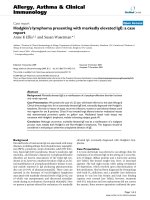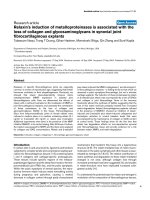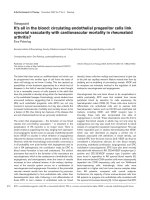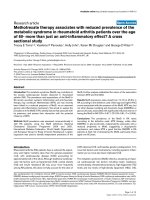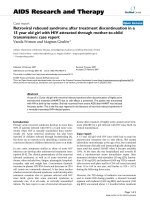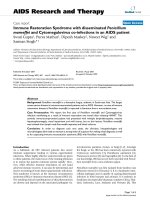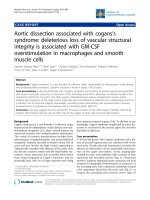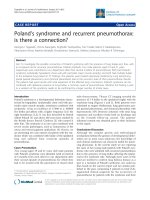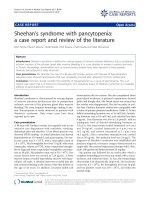Báo cáo y học: "Gitelman’s syndrome with persistent hypokalemia - don’t forget licorice, alcohol, lemon juice, iced tea and salt depletion: a case report" ppsx
Bạn đang xem bản rút gọn của tài liệu. Xem và tải ngay bản đầy đủ của tài liệu tại đây (283.14 KB, 5 trang )
CAS E RE P O R T Open Access
Gitelman’s syndrome with persistent hypokalemia
- don’t forget licorice, alcohol, lemon juice, iced
tea and salt depletion: a case report
Urs Knobel
1*
, Goli Modarres
2
, Markus Schneemann
2
and Christoph Schmid
1
Abstract
Introduction: Chronic hypokalemia is the main finding in patients with Gitelman’s syndrome. Exogenous factors
can trigger deterioration of the patient’s condition and provoke clinical symptoms. We discuss the pathophysiology
of and therapy for Gitelman’s syndrome, with a focus on dietary factors which may aggravate the disease.
Case presentation: We describe the case of a 31-year-old, previously ap parently healthy Caucasian Swiss man
who presented to our hospital with gait disturbance of subacute onset and a potassium level of 1.5 mmol/L. A
detailed medical history revealed that he had been consuming large amounts of licorice (in the form of
Fisherman’s Friend menthol eucalyptus lozenges). Despite discontinuing the intake of glycyrrhizinic acid, his
potassium level remained low. Biochemical investigations showed refractory hypokalemia and secondary
hyperaldosteronism, suggestive of Gitelman’s syndrome. Despite treatment with supplementation of potassium and
magnesium in combination with an aldosterone antagonist, furth er clinically symptomatic episodes occurred.
Triggers could be identified only by repeated detailed history taking. In response to the patient’s dietary excesses
(ingestion of relevant amounts of alcohol, lemon juice and iced tea), his hypokalemia was aggravated and
provoked clinical symptoms. Finally, vomiting and failure to replace salt led to volume depletion and hypokalemic
crisis, with a plasma potassium level of 1.0 mmol/L and paralysis with respiratory failure necessitating not only
infusion of saline and potassium but also temporary mechanical ventilation.
Conclusion: Dietary preferences may have a much larger impact than any drug treatment on the symptoms of
this chronic syndrome. Individual (mainly dietary) preference s must be monitored closely, and patients should be
given dietary advice to avoid recurrent aggravation of hypokalemia with muscular weakness.
Introduction
Hypokalemia is a common clinical problem. It can result
from reduced potassium intake, increased translocation
from extracellular spaces into the cells (as a transient con-
dition) or, most commonly, from increased gastrointestinal
or urinary losses. Increased potassium secretion in the dis-
tal nephr on may account for such los ses, for example,
with the intake of diuretics or because of mineralocorti-
coid excess.
Clinically, a re markable absence of arterial hyperten-
sion and occasional symptoms of hypokalemia, together
with a biochemical constellation of persist ent, refractory
hyp okalemia, metabolic alkalosis, secondary hyperaldos-
teronism, mild hypomagnesemia and hypocalciuria, are
suggestive of Gitelman’ s syndrome. This autosomal
recessive inheritable renal syndrome is caused by defec -
tive sodium chloride (NaCl) t ransporters in the distal
convoluted tubule. In this case report, we discuss how
exogeno us factor s such as licorice, alcohol, lemon juice,
iced tea and low salt intake can further aggravate hypo -
kalemia and provoke clinical symptoms.
Case presentation
A 31-year-old, previously healthy Caucasian Swiss man
was admitted to our hospital because of progressive
weakness of the legs and muscle c ramping which had
developed over the course of a few hours. His clinical
* Correspondence:
1
Endocrinology, Diabetology and Clinical Nutrition, Department of Internal
Medicine, University Hospital of Zürich, Rämistrasse 100, CH-8091 Zürich,
Switzerland
Full list of author information is available at the end of the article
Knobel et al. Journal of Medical Case Reports 2011, 5:312
/>JOURNAL OF MEDICAL
CASE REPORTS
© 2011 Knobel et al; licensee BioMed Central Ltd. This is an Open Access article distributed under the terms of the Creative Commons
Attribution License ( which permits unr estricted use, distr ibution, and reproduction in
any medium, provided the original work is properly cited.
examination revealed paraparesis without sen sory loss.
Otherwise, the physical findings were unremarkable; his
blood pressure in particular was within the normal range
(130/80 mmHg). Biochemical analysis showed severe
hypokalemia (1.5 mmol/L; normal range, 3.6 to
4.5 mmol/L), hypophosphatemia (0.42 mmol/L; normal
range, 0.87 to 1.45 mmol/L) and mild hypomagnesemia
(0.65 mmol/L; normal, 0.7 to 1.1 mmol/L). His calcium
level was initially moderately elevated (with normoalbu-
minemia). His electroc ardiogram (ECG) showed no
arrhythmias, but changes charac teristic of hypokalemi a
with increased amplitude of the U-wave were observed.
His creatine kinase (CK) level was elevat ed (3425 U/L;
normal value, < 190 U/L), indicating rhabdomyolysis. His
renal function was moderately impaired (plasma creati-
nine, 110 μmol/L; normal range, 70 to 105 μmol/L).
There was no evidence of hyperthyroidism (thyroid-sti-
mulating hormone level, 2.3 mU/L; normal range, 0.27 to
4.2 mU/L). His level of active renin (measured on his sec-
ond day in the hospital) was slightly elevated (90.5 mU/L;
normal range, 5 to 50 mU/L), and his aldosterone level
was within the normal range (117.2 ng/L; no rmal rang e,
30 to 200 ng/L). His urine had a low density of 1.010 g/
mL (normal range, 1.020 to 1.030 g/mL), pH8.0, and con-
tained traces of protein. The initial arterial blood gas ana-
lysis showed slight respiratory alkalosis (pH7.47, partial
pressure of CO
2
,4.39kPa;partialpressureofO
2
,8.91
kPa; HCO
3
, 24 mmol/L and base excess 0.7 mmol/L). His
initial family history was non-contributory.
The patient ate a regular European diet without alco-
hol abuse and took no drugs (apart from smoking cigar-
ettes). He had consumed roughly one and a half packets
of original Fisherman’ s Friend menthol eucalyptus
lozenges (Lofthouse of Fleetwood Ltd., Maritime Street,
Fleetwood Lancs, UK) daily for the past three months,
which corresponds to an intake of 60 to 90 mg/day of
glycyrrhizinic acid.
The patient was initially treated with parenteral and
enteral potassium, spironolactone und indomethacin.
Within 24 hours, his potassium level began to rise and
his neurological symptoms disappeared. After three
days, the patient was asymptomatic; at this point, his
potassium level had increased to 2.9 mmol/L (normal
range, 3.6 to 4.5 mmol/L).
At the first follow-up visit two months after he was dis-
charged from our hospital (while taking aldactone 100 mg,
no potassium or magnesium supplements and having con-
sumed no licorice), the patient still had intermittent
cramping without signs of paresis. His potassium level had
again dropped to 2.6 mmol/L (normal range, 3.6 to
4.5 mmol/L), and his m agnesium level was low (0.56
mmol/L; normal range, 0.7 to 1.1 mmol/L). Repeat urina-
lysis showed increased urinary loss of potassium and mag-
nesium with very low calcium excretion. His secondary
hyperaldosteronism was clearly more pronounced than at
the time he first presented to our hospital, with elevated
levels of active renin (287 .8 mU/L; normal range, 5 to 50
mU/L) and aldosterone (917 ng/L; normal range, 30 to
200 ng/L) in blood testing. Morning cortisol and urinary
cortisol excretion were within the normal range.
Under these circumstances, we considered a tubulopathy
causing renal potassium loss. T he biochemical constella-
tion of normal renal function, hypokalemia and mild
hypomagnesemia was suggestive of Gitelman’s syndrome.
We continued treatment with a low dose of an aldos-
terone antagonist (first spironolactone, later epleronone
25 to 50 mg/day), the highest tolerated dose of magne-
sium (10 mmol daily) and potassium supplements. On
this therapeutic regimen, stable hypokalemia (at around
2 mmol/L) could be established.
As an outpatient, our patient reported a few episodes of
muscle weakness and gait disturbance which followed
nights with moderately severe alcohol consumption. After
these episodes disappeared when the patient refrained
from drinking large amounts of alcohol, more severe
hypokalemia developed a few months later. The patient
admitted that he had begun drinking large amounts of
lemon juice, in the form of either seven or eight freshly
prepared lemons daily or by consuming a total of 1 L of
pure lemon juice daily. Another episode of symptomatic
hypokalemia requiring admission to our hospital as an in-
patient was poorly understood but later hist ory taking
revealed that the patient, having experienced weakness,
thirst and moderate weight loss, decided to replace fluid
by drinking, for two days, 5 to 7 L of fluid daily, of which
4 L were consumed in the form of sugar -containing iced
tea. This time muscle weakness had progressed from his
legs to his upper extremities. Apart fro m hypokalemia
(1.2 mmol/L), hypophosphatemia was more pronounced
(0.26 mmol/L) despite a moderate rise in creatinine (to
158 μmol/L). His sodium level was 132 mmol/L, and his
fasting glucose level was somewhat elevated (8.6 mmol/L).
The patient had progressive truncal weakness and finally
presented with respiratory failure, necessitating temporary
mechanical ventilation. At this point, extreme hypokale-
mia of 1.0 mmol/L was evident; his creatinine level was
206 μmol/L. For reasons of his own, the patient had
started a new diet with restricted sodium intake. Two days
after being weaned from assisted ventilation, the patient
insisted on being discharged from our hospital. Four days
later he had a potassium level of 2.6 mmol/L and a normal
resting ECG reading, and a prolonged QTc time was
found only during a bicycle exercise test, during which he
showed a normal exercise performance of up to 150 W.
Discussion
Our patient, a 31-year old, previous ly healthy Caucasian
Swiss man, had a case of impressive symptomatic
Knobel et al. Journal of Medical Case Reports 2011, 5:312
/>Page 2 of 5
hypokalemia. His neurological symptoms (cramping and
muscle weakness) resolved rapidly after correction of
hypokalemia.
Hypokalemic paresis (paralysis) may be acquired in
patients with thyrotoxicosis [1]. Our patient showed
neither clinical nor biochemical signs of this disease,
which is mainly found in Asi ans but still is more com-
mon as a cause of severe neurological symptoms in a
patient presenting with hypokalemia in our hospital
than Gitelman’s syndrome, with the latter being more
commonly found by chance on the basis of a labo ratory
finding of low potassium. Our patient had no history
suggestive of familial periodic paralysis. This rare, her-
editary defect of calcium or magnesium channels in ske-
letal muscles enhances the likelihood that insulin
secreted after the intake of carbohydrate-rich food or
catecholamine bursts (in response to stress or exertion)
will result in increased potassium entry into the muscle,
so that a substantial decrease in plasma potassium levels
can ensue.
In our patient, we suspected a connection between his
hypokalemia and his prolonged intake of Fisherman’s
Friend lozenges. These sweets contain licorice and the
active substance glycyrrhizinic acid, which inhibits the
renal enzyme 11b-hydroxysteroid dehydrogenase (type 2)
and thereby converts cortisol (with mineralocorticoid
activity) into c orti sone (withou t mineralocorticoid activ-
ity). The local (paracrine) renal cortisol excess then leads
to heightened mineralocorticoid receptor-mediated effects
(pseudohyperaldosteronism or a syndrome of apparent
mineralocorticoid excess). Regulated by intact adrenocorti-
cotropic hormone feedback, systemic cortisol levels
remain stable. Regulated by intact renin-angiotensin II
loop feedback, renin activity ought to be suppressed. In a
healthy individual, glycyrrhizinic acid (above 50 mg daily)-
induced pseudohyperal doster onism m ay cause hyperten-
sion within 14 days [2]. Furthermore, chronic ingestion
will lead to hypokalemia with its known symptoms (mus-
cle weakness, muscle pain and palsy).
Making the correct diagnosis depends on obtaining a
precise medical history. Biochemical analysis shows the
typical constellation of exogenously triggered excessive
mineralocorticoid activity with suppressed renin activity,
low aldosterone levels and metabolic alkalosis.
In patients in whom it is unclear whe ther licorice has
been ingested, 24-hour urine collection may be helpful.
The atypica l constellation of a free cortisone level lower
than the free cortisol level (reduced 11b-hydroxysteroid
dehydrogenase activity) should raise clinical suspicions
of pseudohyperaldosteronism [3].
Our patient presented with hypokalemia, but w ithout
hypertens ion. Despite having discontinued his consump-
tion Fisherman’s Friend lozenges, his hypokalemia per-
sisted and his potassium remained at levels of around
2 mmol/L. Although they were checked only on the sec-
ond day of his hospital stay, his active renin and aldoster-
one did not appear to be fully suppressed, but were rather
slightly increased and normal, respectively. In the later
course of his illness, these values increased further,
demonstrating more clearly the secondary hyperaldoster-
onism characteristic of his chronic disorder. This presen-
tation implied that the patient had experienced previous
chronic hypokalemia with glycyrrhizinic acid-triggered
decompensation. It may be rather unique (but fully com-
patible with his underlying disorder) that increased corti-
sol activity at the mineralocorticoid receptor could not
fully suppress renin and did not induce arterial hyperten-
sion in this patient.
In normotensive patients with secondary hyperaldoster-
onism, not only diuretic use or abuse but also tubulopathy
causing renal potassium loss should be considered.
Normal renal function, hypokalemia, hypermagnesiuria
with hypomagnesemia and (in not documented in our
patient) metabolic alkalosis are diagnosti c for Gitelman ’ s
syndrome, a disease mostly detected in young adults [4].
As discussed in the review article by Knoers and Levtch-
enko [5], this autosomal recessive disease (OMIM 263800)
is the most frequent inherited salt-losing renal tubulopathy
(prevalence estimated at 1:40,000). In the great majority of
patients, it is caused by one of more than 140 described
mutations in the solute carrier family 12, SLC12A3 gene
(chromosome 16q13), encoding the renal thiazide-sensi-
tive NaCl co-transporters (NCCT), expressed in the apical
membrane of the first part of the distal convoluted tubule.
An inherited origin of our patient’s disease was initially far
from obvious, and, up to the time of this writing, genetic
testing has not been performed so that the mutat ions
underly ing his disorder remain unch arac terized. Most of
the patients are compound heterozygous with different
NCCT mutations on each allele [6]. Several years after our
patient’s initial present ation to our hospital, we learned
from his sister, who was visiting him in the intensive care
unit, that she also was found to have hypokalemia ranging
between2.6and3mmol/L,butthatshehadneverhad
any symptoms of the disorder.
Impaired NaCl reabsorption results in mild volume
depletion. Secondary hyperreninemic hyperaldosteron-
ism tends to correct sodium homeostasis at th e expense
of depletion of potassium and hydrogen ions, resulting
in hypokalemia and metabolic alkalosis.
Elevated magnesium excretion in the proximal tubule
is assumed to cause hypomagnesemia. Occasionally, asso-
ciated chondrocalcinosis is probably caused by chronic
hypomagnesemia. The pathogenesis of hypocalciuria is
not entirely clear, but may be due either to extracellular
volume contraction and increased passive Calcium reab-
sorption in the proximal tubule or to reduced luminal
NaCl entry into distal convoluted tubular cells, cellular
Knobel et al. Journal of Medical Case Reports 2011, 5:312
/>Page 3 of 5
hyperpolarization and a basolateral calcium shift. Hypo-
phosphatemia is not reg ularly observed. Apart from tub-
ular dysfunction (with reduced phosphate reabsorption),
metabolic alkalosis can increase phosphate excretion, and
the accompanying h ypokalemia furthe r increases rena l
phosphate clearance [7].
The differential diagnosis includes classical Bartter’ s
syndrome (especially type III) . In classic Bartter’ssyn-
drome, patients ty pically present with severe sympto ms
(polyuria, polydipsia, dehydration and vomiting) in early
childhood and often exhibit dysmorphic syndromes.
Retardation of g rowth or mental development is a fea-
ture of untreated Bartter’s syndrome. Different subtypes
can be distingui she d. All of them are characterized bio-
chemically by hypokalemic metabolic alkalosis, but i n
contrast to the hypocalciuria in Gitelman’ssyndrome,
Bartter’ s syndrome is characterized by hypercalciuria
and medullary nephrocalcinosis is frequently observed
[8].
Therapeutic options in Gitelman’s syndrome are lim-
ited. As the tubulopathy cannot be modified, supple-
mentation of potassium and magnesium is, apart from
avo iding sodium depletion , the therapeutic cornerstone.
However, the typically high substitution doses are asso-
ciated with partly unacceptable gastrointestinal side
effects. Thus, asymptomatic stable hypokalemia and bor-
derline hypomagnesem ia are a realistic therapeut ic goal.
Sufficient salt intake is important because low NaCl
supply exaggerates volume depletion and increases the
compensatory secondary hyperaldosteronism, resulting
in intensified hypokalemia.
Although the use of an aldosterone antagonist can stabi-
lize the hypokalemia, it competes with the compensatory
secondary hyperaldosteronism. This can result in hypovo-
lemia, possibly acce ntuated hyponatremia and eventually
symptomatic hypotonia. Similar effects occur with the use
of angiotensin-converting enzyme inhibitors or angioten-
sin 2 receptor blockers. Apart from isolated cases in which
renal insufficiency developed, Gitelman’s syndrome usually
carries a very good prognosis.
Our patient was treated with a low dose of an aldoster-
one antagonist, the highest tolera ted dose of magnesium,
and potassium supp lements. By applying this therapeutic
regimen, a stable hypokalemia (at around 2 mmol/L) was
established. During the following years, our patient experi-
enced recurrent episodes of sympto matic hypokalemia,
finally climaxing in severe respiratory muscle weakness
with respiratory failure requiring temporary assisted venti-
lation. Only a detailed evaluation obtai ned by careful
history taking revealed various interfering factors.
As an outpatient, he reported a few episodes of mus-
cle weakness and gait disturbance which fo llowed nights
of moderately severe alcohol consumption. Alcohol is
known to c ause functional tubular defects, particularly
with hypomagnesemia [9].
More severe episodes (more severe muscle cramping,
attacks of pain and weakness) with more severe hypoka-
lemia followed his consumption of large amounts of
lemon juice. This presentation favors metaboli c alkalosis
and a further fall in plasma potassium concentration.
Once the excessive lemon juice intake was discontinued,
his potassium levels stabilized.
Another episode of even more pronounced symptomatic
(muscle weakness extending from the legs to the upper
extremities) hypokalemia (1.2 mmol/L) requiring admis-
sion to our hospital as an in-patient followed excessive
consumption of sugar-containing iced tea. Consumption
of large quantities of carbohydrates increases insulin secre-
tion and thus enhances potassium influx into myocytes
and hepatocytes, with a consequential fall in plasma potas-
sium [10]. Additionally, his intake of low-sodium drinks
was far from optimal to restore plasma volume and (pre-
sumably via hypovolemia-driven ant i-di ureti c h ormone
secretion) exacerbated his hyponatremia.
Last, the patient had progressive truncal weakness and
finally presented with respiratory failure, necessitating
temporary mechanical ventilation. At this point, extreme
hypokalemia of 1.0 mmol/L was evident. The patient had
started a new diet with restricted sodium intake. He later
explained that he had vomited the day before being
admitted to our hospital; in retrospect, the p atient was
found to have lost 2 kg of his body weight. As mentioned
above, a low NaCl supply exaggerates volume depletion,
enhancing compensatory secondary hyperaldosteronism
and hypokalemia.
Conclusion
The present case report illustrates the impressive compli-
cations encountered in a young patient with Gitelman’s
syndrome, especially in response to dietary challenges and
excesses. It is remarkable that the patient’s i ndividual diet-
ary preferences had a much larger impact on the symp-
toms attributable to his chronic disorder than any drug
treatment prescribed by his physicians over the past four
years. We have discussed some pathophysiological
mechanisms leading to recurrent exacerbation of hypoka-
lemia and clinical deterioration. Consequently, individual
(mainly dietary) prefere nces must be monit ored closely,
and patients should be given dietary advice to avoid recur-
rent aggravation of hypokalemia with muscular weakness.
Consent
Written informed consent was obtained from the patient
for publication of this case report and a ny accompany-
ing images. A copy of the written consent is available
for review by the Editor-in-Chief of this journal.
Knobel et al. Journal of Medical Case Reports 2011, 5:312
/>Page 4 of 5
Abbreviations
ACE: angiotensin-converting enzyme; ACTH: adrenocorticotropic hormone;
ADH: anti-diuretic hormone; AT2R: angiotensin 2 receptor; Ca: calcium; ECG:
electrocardiogram; HCO
3
: hydrogen carbonate; NaCl: sodium chloride; QTc:
corrected QT interval; pCO
2
: partial pressure of carbon dioxide; pO
2
: partial
pressure of oxygen; TSH: thyroid-stimulating hormone.
Author details
1
Endocrinology, Diabetology and Clinical Nutrition, Department of Internal
Medicine, University Hospital of Zürich, Rämistrasse 100, CH-8091 Zürich,
Switzerland.
2
Internal Medicine, Department of Internal Medicine, University
Hospital of Zürich, Rämistrasse 100, CH-8091 Zürich, Switzerland.
Authors’ contributions
All authors read and approved the final manuscript.
Competing interests
The authors declare that they have no competing interests.
Received: 29 October 2010 Accepted: 14 July 2011
Published: 14 July 2011
References
1. Kung AW: Thyrotoxic periodic paralysis: a diagnostic challenge. J Clin
Endocrinol Metab 2006, 91:2490-2495.
2. Stewart PM: Tissue-specific Cushing’s syndrome, 11-hydroxysteroid-
dehydrogenase and redefinition of corticosteroid hormone action. Eur J
Endocrinol 2003, 149:163-168.
3. Palermo M, Shackleton CHL, Mantero F, Stewart PM: Urinary free cortisone
and the assessment of 11β-hydroxysteroid dehydrogenase activity in
man. Clin Endocrinol (Oxf) 1996, 45:605-611.
4. Gitelman HJ, Graham JB, Welt LG: A new familial disorder characterized
by hypokalemia and hypomagnesemia. Trans Assoc Am Physicians 1966,
79:221-235.
5. Knoers NVAM, Levtchenko EN: Gitelman syndrome. Orphanet J Rare Dis
2008, 3:22.
6. Sung CC, Chen YS, Lin SH: Family paralysis. Lancet 2011, 377:352.
7. Katopodis K, Elisaf M, Siamopoulos KC: Hypophosphataemia in a patient
with Gitelman’s syndrome. Nephrol Dial Transplant 1996, 11:2090-2092.
8. Peters M, Jeck N, Reinalter S, Leonhardt A, Tönshoff B, Klaus G, Konrad M,
Seyberth HW: Clinical presentation of genetically defined patients with
hypokalemic salt-losing tubulopathies. Am J Med 2002, 112:183-190.
9. De Marchi S, Cecchin E, Basile A, Bertotti A, Nardini R, Bartoli E: Renal
tubular dysfunction in chronic alcohol abuse: effects of abstinence. N
Engl J Med 1993, 329:1927-1934.
10. Ferrannini E, Taddei S, Santoro D, Natali A, Boni C, Del Chiaro D, Buzzigoli G:
Independent stimulation of glucose metabolism and Na
+
-K
+
exchange
by insulin in the human forearm. Am J Physiol 1988, 255:E953-E958.
doi:10.1186/1752-1947-5-312
Cite this article as: Knobel et al.: Gitelman’s syndrome with persistent
hypokalemia - don’t forget licorice, alcohol, lemon juice, iced tea and
salt depletion: a case report. Journal of Medical Case Reports 2011 5:312.
Submit your next manuscript to BioMed Central
and take full advantage of:
• Convenient online submission
• Thorough peer review
• No space constraints or color figure charges
• Immediate publication on acceptance
• Inclusion in PubMed, CAS, Scopus and Google Scholar
• Research which is freely available for redistribution
Submit your manuscript at
www.biomedcentral.com/submit
Knobel et al. Journal of Medical Case Reports 2011, 5:312
/>Page 5 of 5
